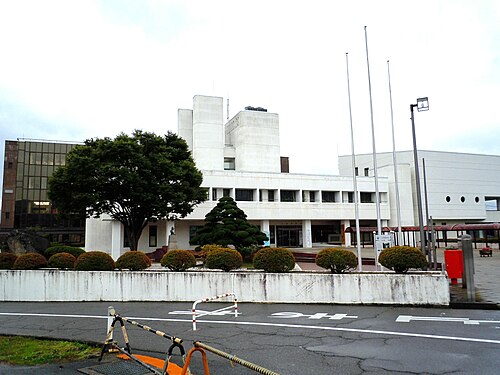This articleneeds additional citations forverification. Please helpimprove this article byadding citations to reliable sources. Unsourced material may be challenged and removed. Find sources: "Kaminoyama" – news ·newspapers ·books ·scholar ·JSTOR(January 2017) (Learn how and when to remove this message) |
Kaminoyama 上山市 | |
|---|---|
 Kaminoyama City Hall | |
 Location of Kaminoyama in Yamagata Prefecture | |
| Coordinates:38°8′58.5″N140°16′4.3″E / 38.149583°N 140.267861°E /38.149583; 140.267861 | |
| Country | Japan |
| Region | Tōhoku |
| Prefecture | Yamagata |
| Area | |
• Total | 240.93 km2 (93.02 sq mi) |
| Population (February 2015) | |
• Total | 29,974 |
| • Density | 120/km2 (320/sq mi) |
| Time zone | UTC+9 (Japan Standard Time) |
| City symbols | |
| - Tree | Japanese yew |
| - Flower | Chrysanthemum |
| - Bird | Little egret |
| Phone number | 023-672-1111 |
| Address | 1-1-10 Kawasaki, Kaminoyama-shi, Yamagata-ken 999-3192 |
| Website | Official website |

Kaminoyama (上山市,Kaminoyama-shi) is acity located inYamagata Prefecture,Japan. As of 31 October 2020[update], the city had an estimatedpopulation of 29,617 in 11278 households,[1] and apopulation density of 120 persons per km2. The total area of the city is 240.93 square kilometres (93 sq mi).
Kaminoyama is located in southeast Yamagata Prefecture, in the Murayama Basin, bordered byMiyagi Prefecture to the east.Mount Zaō is located within its borders.
Kaminoyama has aHumid continental climate (Köppen climate classificationCfa) with large seasonal temperature differences, with warm to hot (and often humid) summers and cold (sometimes severely cold) winters. This includes heavy amounts of snowfall from late November until early March. Precipitation is significant throughout the year, but is heaviest from August to October. The average annual temperature in Kaminoyama is 11.4 °C. The average annual rainfall is 1362 mm with September as the wettest month. The temperatures are highest on average in August, at around 24.9 °C, and lowest in January, at around -1.1 °C.[2]
Per Japanese census data,[3] the population of Kaminoyama has declined over the past 40 years.
| Year | Pop. | ±% |
|---|---|---|
| 1960 | 40,383 | — |
| 1970 | 38,357 | −5.0% |
| 1980 | 38,533 | +0.5% |
| 1990 | 38,327 | −0.5% |
| 2000 | 36,886 | −3.8% |
| 2010 | 33,836 | −8.3% |
| 2020 | 29,110 | −14.0% |
The area of present-day Kaminoyama was part of ancientDewa Province, and was acastle town forKaminoyama Domain under theTokugawa shogunate in theEdo period. It was also apost station on theUshū Kaidō highway. After the start of theMeiji period, the area became part ofMinamimurayama District, Yamagata Prefecture. The town of Kaminoyama was established on April 1, 1889 with the establishment of the modern municipalities system, and was elevated to city status on October 1, 1954.[citation needed]
Higashine has amayor-council form of government with a directly elected mayor and aunicameral city legislature of 15 members. The city contributes one member to the Yamagata Prefectural Assembly. In terms of national politics, the city is part of Yamagata District 1 of thelower house of theDiet of Japan.
The economy of Kaminoyama is based on agriculture (horticulture), light manufacturing (electronics, automotive components, clothing, foodstuffs), forestry and tourism. This region is famous for its hot spring water and hot spring resorts near the former grounds of Kaminoyama Castle[4]
Kaminoyama has five public elementary schools and three public middle schools operated by the city government and one public high schools operated by the Yamagata Prefectural Board of Education. The prefecture also operates one special education school for the handicapped and two vocational training schools.
 East Japan Railway Company -Yamagata Shinkansen
East Japan Railway Company -Yamagata Shinkansen
 East Japan Railway Company -Ōu Main Line
East Japan Railway Company -Ōu Main Line
 Tōhoku-Chūō Expressway – Yamagata-Kamiyama Interchange, Kaminoyama-Minami Interchange
Tōhoku-Chūō Expressway – Yamagata-Kamiyama Interchange, Kaminoyama-Minami Interchange National Route 13
National Route 13 National Route 458
National Route 458
 Donaueschingen,Baden-Württemberg, Germany, since October 1, 1995.[5]
Donaueschingen,Baden-Württemberg, Germany, since October 1, 1995.[5]